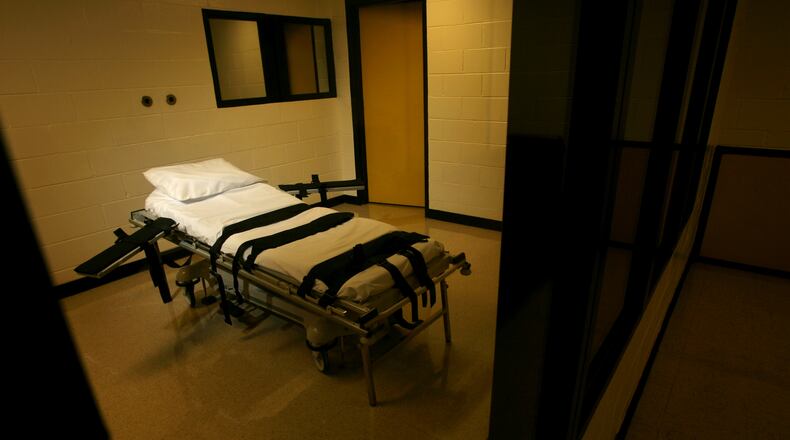The jury that decided decades ago that John Wayne Conner should die knew nothing of the frightening path he traveled as a child — a path that led him to become a killer in his 20s, his lawyers say.
Conner, who has been on Death Row for 34 years, is scheduled to die by lethal injection at 7 p.m. Thursday. If he is put to death, the 60-year-old man will be the sixth person Georgia has executed this year, more than any other in year since the current death penalty law was adopted 40 years ago.
On Wednesday, Conner’s lawyers will meet with the State Board of Pardons and Paroles to make a case for commuting his death sentence to life in prison without the possibility of parole. Later in the day, the Telfair County prosecutor will present his argument for carrying out the execution as scheduled.
» INTERACTIVE: Who is on Georgia's Death Row?
» PHOTOS: Georgia's executed Death Row inmates and their victims
If the jurors at his trial had known of Conner's horrific childhood, the lawyers wrote in a clemency petition filed with the parole board, they might have shown mercy when they decided his fate for the 1982 murder of J.T. White.
“A child’s sense of normalcy is defined not by the outside world’s social norms, but rather by his immediate family and home life,” the clemency petition said. “For young John Wayne Conner, normalcy included extraordinary familial violence that frequently involved knives and guns; regular drug and alcohol abuse; and brutal physical, sexual and emotional abuse.”
Those circumstances, the clemency petition said, led Conner “into the pattern modeled by those in his family.”
The lawyers wrote that they were not recounting the details of Conner’s life to excuse the murder of White but as an explanation of how Conner came to be a killer.
Conner, then 25, and White, 29, had spent the evening of Jan. 9, 1982, at a party, and wanted to keep drinking once they returned to Conner's house in Milan. The two men walked to a neighbor's house in search of a ride to the liquor store, but the neighbor refused. They were walking back to Conner's house when the pair got into a fight; White said he wanted to have sex with Conner's girlfriend, Beverly Bates. Conner beat White with a quart bottle and an oak tree branch.
Leaving White in a ditch, Conner went directly home and told Bates they needed to leave town. On their way out of town, the couple stopped at the ditch so Conner could be sure White was dead.
Bates told investigators Conner walked into the woods and moments later she heard a thud. Conner then told him he was sure.
Conner and Bates were arrested the next day.
The attorneys wrote in the petition that Conner’s abusive father had taught him to be violent, but that information was not presented at trial nor was it included in his appeals that followed.
“Imagine a man who evokes fear and repugnance from an entire community,” the petition said.
The petition said Carroll Conner slit a man’s throat after the man brushed against the arm of Conner’s pregnant wife. They also said that Carroll Conner, while serving overseas during World War II, beheaded a man in a movie theater for sitting in the seat between him and his brother. The petition said Conner’s father stabbed his brother and father-in-law, sexually assaulted his daughters and cut up his wife “like a jigsaw puzzle.”
Conner, called “Shorty” by his family, was routinely beaten and mocked for his “limited intellectual functioning,” the petition said. And sometimes Conner and his siblings slept in the woods to avoid their father, his lawyers wrote, citing accounts by some of Conner’s brothers and sisters. They were so poor that for many of his early years, the family home did not have indoor plumbing.
The petition said Conner dealt with his violent upbringing by using drugs and alcohol, and tried to kill himself with an overdose and also by hanging.
Conner’s defense attorney failed him as well, the lawyers wrote.
“Mr. Conner was represented at trial by a young appointed attorney, who was wholly inexperienced in capital defense and neglected to investigate Mr. Conner’s mental health, cognitive functioning or violent and traumatic family background,” according to the petition.
The lawyer put on no defense and did not call witnesses during the sentencing phase of the trial.
That information also was not included in appeals until now, the petition said.
The petition notes that prison had made Conner a better man, that he has found religion and has taken up painting; they attached a copy of his artwork to the petition.
“John Wayne Conner is a testament to the rehabilitative process,” his lawyers wrote. “Despite being on Death Row for the last 34 years without hope for release, Mr. Conner has transformed himself from a violent young man with severe substance abuse problems into a peaceful and productive member of the prison community.”
About the Author
The Latest
Featured


